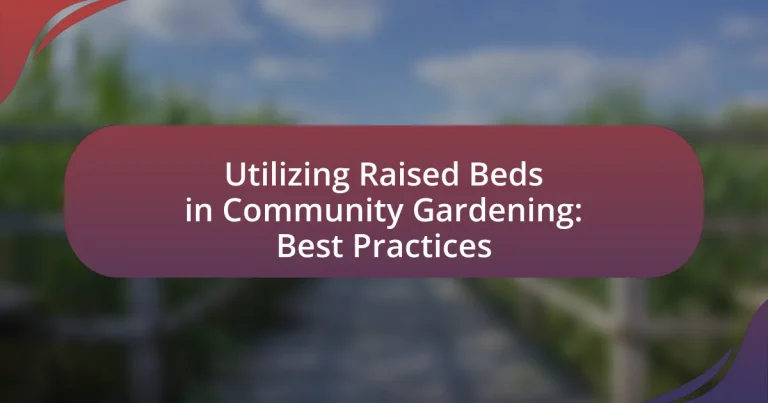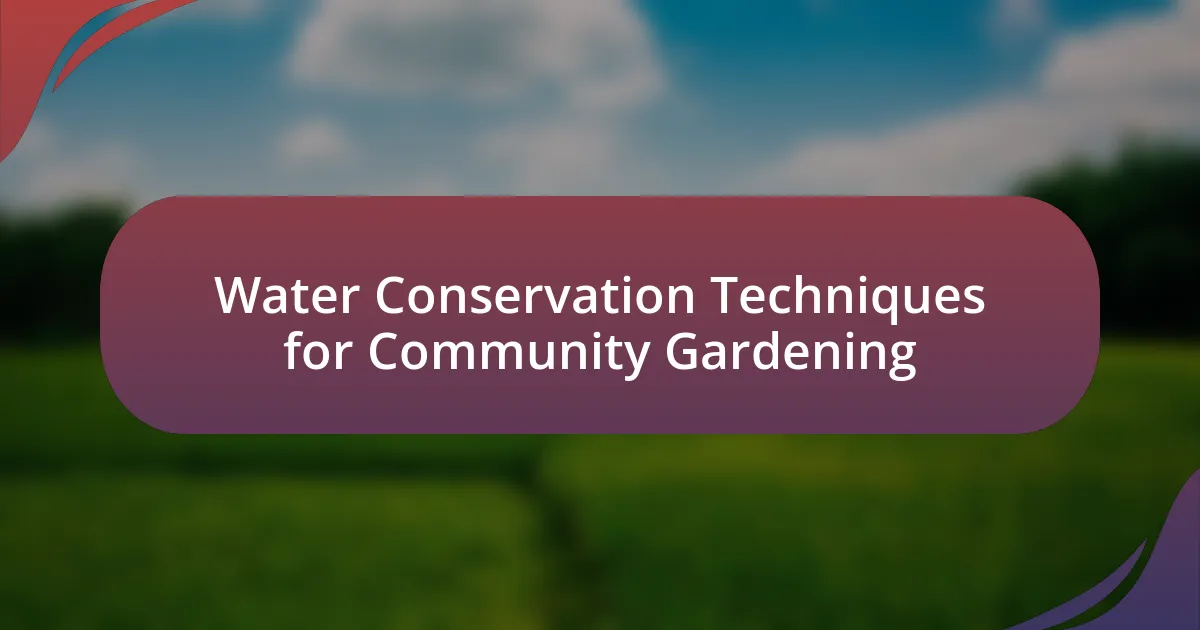Raised beds in community gardening are elevated planting areas that enhance soil drainage, accessibility, and crop yields. This article explores the differences between raised beds and traditional gardening methods, detailing the materials and dimensions ideal for construction. It highlights the benefits of raised beds, including improved soil quality, pest management, and effective water management strategies. Additionally, best practices for positioning, soil composition, and seasonal maintenance are discussed, providing practical tips for community members to collaborate effectively in maintaining these gardens. Overall, the article serves as a comprehensive guide to optimizing raised bed gardening in community settings.

What are Raised Beds in Community Gardening?
Raised beds in community gardening are elevated planting areas, typically framed with wood, stone, or other materials, designed to improve soil drainage and accessibility. These structures allow for better control over soil quality, reduce weed growth, and can extend the growing season by warming the soil more quickly in spring. Research indicates that raised beds can increase crop yields by providing optimal growing conditions, as they allow for better aeration and root development.
How do raised beds differ from traditional gardening methods?
Raised beds differ from traditional gardening methods primarily in their structure and soil management. Raised beds are elevated garden plots that allow for better drainage, improved soil quality, and easier access for planting and maintenance. In contrast, traditional gardening typically involves planting directly in the ground, which can lead to issues like poor drainage and soil compaction. Studies have shown that raised beds can increase crop yields by up to 30% due to enhanced soil conditions and reduced weed competition, making them a more efficient option for gardeners.
What materials are commonly used to construct raised beds?
Common materials used to construct raised beds include wood, metal, stone, and composite materials. Wood, particularly untreated cedar or redwood, is favored for its durability and natural resistance to decay. Metal, such as galvanized steel, offers longevity and a modern aesthetic, while stone provides a sturdy and natural look. Composite materials, made from recycled plastics and wood fibers, are also popular for their resistance to rot and low maintenance requirements. These materials are chosen based on factors like availability, cost, and the desired aesthetic of the garden.
What dimensions are ideal for raised beds in community gardens?
The ideal dimensions for raised beds in community gardens are typically 4 feet wide by 6 to 8 feet long and 12 to 24 inches high. These dimensions allow for easy access from both sides without stepping into the bed, facilitating maintenance and harvesting. Research indicates that a width of 4 feet maximizes accessibility while maintaining a manageable size for various crops, as noted in studies by the American Community Gardening Association, which emphasize the importance of ergonomic design in gardening practices.
Why are raised beds beneficial for community gardening?
Raised beds are beneficial for community gardening because they improve soil drainage and enhance soil quality. The elevated structure allows for better aeration and reduces soil compaction, which is crucial for healthy root development. Additionally, raised beds can be filled with high-quality soil and compost, providing optimal growing conditions for plants. Research indicates that raised beds can increase yields by up to 30% compared to traditional in-ground gardening methods, as they allow for better control over soil conditions and reduce competition from weeds.
How do raised beds improve soil quality and drainage?
Raised beds improve soil quality and drainage by allowing for better aeration and moisture control. The elevated structure of raised beds promotes drainage by preventing water from pooling, which reduces the risk of root rot and other water-related issues. Additionally, the soil in raised beds can be customized with organic matter, such as compost, which enhances nutrient availability and soil structure. Research indicates that raised beds can increase soil temperature, leading to improved microbial activity and faster plant growth, further supporting the overall health of the soil ecosystem.
What advantages do raised beds offer for pest management?
Raised beds offer several advantages for pest management, primarily by improving drainage and soil quality, which can deter pests. The elevated structure of raised beds allows for better air circulation and sunlight exposure, creating an environment less conducive to pests and diseases. Additionally, the physical barrier of raised beds can help prevent certain pests, such as slugs and snails, from accessing the plants. Research indicates that raised beds can also facilitate companion planting, which can naturally repel pests and attract beneficial insects. These factors collectively contribute to a healthier growing environment, reducing the reliance on chemical pest control methods.

What Best Practices Should Be Followed When Utilizing Raised Beds?
To effectively utilize raised beds, gardeners should follow best practices such as selecting the right location, using quality soil, and implementing proper watering techniques. Choosing a location with adequate sunlight and good drainage is crucial for plant health. Quality soil, ideally a mix of compost, topsoil, and other organic materials, ensures nutrient availability and promotes healthy root development. Additionally, consistent watering practices, such as deep watering to encourage root growth and mulching to retain moisture, are essential for maintaining optimal growing conditions. These practices are supported by research indicating that raised beds can enhance plant growth and yield due to improved soil quality and drainage.
How should raised beds be positioned within a community garden?
Raised beds in a community garden should be positioned to maximize sunlight exposure and accessibility for gardeners. Ideally, they should be oriented north to south to ensure that all plants receive adequate sunlight throughout the day. This orientation allows for even light distribution, which is crucial for plant growth. Additionally, raised beds should be spaced to allow easy access for maintenance and harvesting; a common recommendation is to leave at least 3 feet of walking space between beds. This spacing facilitates movement and reduces soil compaction, which can negatively affect plant health.
What factors influence the placement of raised beds?
The placement of raised beds is influenced by factors such as sunlight exposure, soil drainage, accessibility, and proximity to water sources. Sunlight exposure is crucial, as raised beds should ideally receive at least six hours of direct sunlight daily to support plant growth. Soil drainage is another important factor; raised beds should be placed in areas where water does not pool, ensuring that plants do not suffer from root rot. Accessibility is essential for maintenance and harvesting, so raised beds should be positioned for easy reach without obstructing pathways. Lastly, proximity to water sources facilitates efficient irrigation, making it easier to maintain the moisture levels necessary for healthy plant growth.
How does sunlight exposure affect plant growth in raised beds?
Sunlight exposure significantly enhances plant growth in raised beds by providing the necessary energy for photosynthesis. Adequate sunlight allows plants to produce food, leading to healthier growth, increased yields, and improved resilience against pests and diseases. Research indicates that most vegetables require at least six hours of direct sunlight daily to thrive, with some, like tomatoes and peppers, benefiting from even more exposure. Studies have shown that plants grown in full sun can yield up to 20% more produce compared to those in partial shade, demonstrating the critical role of sunlight in maximizing growth potential in raised bed gardening.
What soil mix is recommended for raised beds?
A recommended soil mix for raised beds consists of one-third compost, one-third peat moss or coconut coir, and one-third vermiculite or perlite. This combination provides a well-draining, nutrient-rich environment that supports healthy plant growth. Compost supplies essential nutrients and beneficial microorganisms, while peat moss or coconut coir enhances moisture retention. Vermiculite or perlite improves aeration and drainage, preventing soil compaction. This mix is widely endorsed by gardening experts and organizations, ensuring optimal conditions for a variety of plants in raised bed gardening.
How can compost enhance the soil quality in raised beds?
Compost enhances soil quality in raised beds by improving soil structure, increasing nutrient availability, and promoting beneficial microbial activity. The organic matter in compost helps to create a looser soil texture, which improves aeration and drainage, essential for healthy root development. Additionally, compost provides a balanced supply of nutrients, including nitrogen, phosphorus, and potassium, which are vital for plant growth. Research indicates that compost can increase soil fertility by up to 30%, as demonstrated in studies conducted by the University of California, which found that composted materials significantly boost nutrient levels in garden soils. Furthermore, the microbial life introduced through compost aids in the breakdown of organic matter, enhancing soil health and resilience against pests and diseases.
What role do fertilizers play in maintaining raised bed gardens?
Fertilizers play a crucial role in maintaining raised bed gardens by providing essential nutrients that support plant growth and health. In raised bed gardens, soil can become depleted of nutrients more quickly due to limited volume and increased plant density. Fertilizers replenish these nutrients, such as nitrogen, phosphorus, and potassium, which are vital for processes like photosynthesis, root development, and overall plant vigor. Research indicates that using balanced fertilizers can enhance crop yields by up to 20% in intensive gardening systems, demonstrating their effectiveness in optimizing plant performance in raised beds.

What Challenges Might Arise with Raised Bed Gardening?
Raised bed gardening can present several challenges, including soil drainage issues, pest management difficulties, and higher initial costs. Soil drainage can be problematic if the raised beds are not designed properly, leading to waterlogging or insufficient moisture retention. Pest management can become more complex as raised beds may attract certain pests that thrive in elevated environments, requiring gardeners to implement additional control measures. Furthermore, the initial investment for materials and construction of raised beds can be significantly higher compared to traditional gardening methods, which may deter some individuals from adopting this approach.
How can water management be effectively handled in raised beds?
Effective water management in raised beds can be achieved through a combination of proper irrigation techniques, soil selection, and mulching. Utilizing drip irrigation systems allows for targeted watering, minimizing water waste and ensuring that plants receive adequate moisture directly at their roots. Additionally, incorporating organic matter into the soil enhances its water retention capacity, which is crucial for raised beds that may dry out more quickly than traditional garden plots. Mulching with materials such as straw or wood chips further reduces evaporation and helps maintain consistent soil moisture levels. Research indicates that these practices can lead to improved plant health and yield, as they create an optimal growing environment by balancing moisture levels effectively.
What irrigation methods are most effective for raised beds?
Drip irrigation and soaker hoses are the most effective irrigation methods for raised beds. Drip irrigation delivers water directly to the plant roots, minimizing evaporation and runoff, while soaker hoses allow water to seep slowly into the soil, ensuring even moisture distribution. Research indicates that these methods can reduce water usage by up to 50% compared to traditional overhead watering, making them both efficient and sustainable for raised bed gardening.
How can gardeners prevent overwatering in raised beds?
Gardeners can prevent overwatering in raised beds by implementing proper drainage techniques and monitoring soil moisture levels. Installing a layer of gravel or coarse sand at the bottom of the raised bed enhances drainage, allowing excess water to escape. Additionally, using a moisture meter helps gardeners assess soil moisture accurately, ensuring they only water when necessary. Research indicates that raised beds with adequate drainage can reduce the risk of root rot and promote healthier plant growth, as demonstrated in studies by the University of California Cooperative Extension, which emphasize the importance of balanced watering practices in raised bed gardening.
What common pests and diseases affect raised bed gardens?
Common pests that affect raised bed gardens include aphids, spider mites, and whiteflies, while diseases such as powdery mildew and root rot are prevalent. Aphids can rapidly reproduce and damage plants by sucking sap, leading to stunted growth. Spider mites thrive in dry conditions and can cause leaf discoloration and webbing. Whiteflies, similar to aphids, feed on plant sap and can transmit viruses. Powdery mildew is a fungal disease that appears as white powder on leaves, often thriving in humid conditions, while root rot, caused by overwatering or poor drainage, leads to plant wilting and death. These pests and diseases can significantly impact the health and yield of plants in raised bed gardens.
How can organic methods be used to control pests in raised beds?
Organic methods can be used to control pests in raised beds through techniques such as companion planting, natural repellents, and beneficial insects. Companion planting involves growing specific plants together that can deter pests; for example, marigolds are known to repel nematodes and aphids. Natural repellents, such as neem oil or insecticidal soap, can be applied to affected plants to manage pest populations without harming beneficial organisms. Additionally, introducing beneficial insects like ladybugs and lacewings can help control aphid populations naturally. These methods are effective as they promote a balanced ecosystem, reducing reliance on synthetic pesticides and fostering a healthier garden environment.
What preventative measures can be taken to reduce disease risk?
Preventative measures to reduce disease risk in community gardening include implementing crop rotation, maintaining proper soil health, and practicing good sanitation. Crop rotation disrupts pest and disease cycles, reducing the likelihood of outbreaks. Maintaining soil health through organic amendments and proper drainage minimizes conditions conducive to disease. Good sanitation practices, such as removing diseased plants and cleaning tools, further prevent the spread of pathogens. Research indicates that these practices significantly lower disease incidence, enhancing overall garden productivity and health.
What are some practical tips for successful raised bed gardening?
To achieve successful raised bed gardening, ensure proper soil composition by mixing high-quality topsoil, compost, and organic matter in a ratio of 60:30:10. This mixture promotes healthy plant growth and improves drainage. Additionally, select a location that receives at least six hours of sunlight daily, as most vegetables thrive in full sun. Implementing a watering schedule that maintains consistent moisture without waterlogging is crucial; raised beds tend to dry out faster than traditional gardens. Furthermore, using mulch can help retain soil moisture and suppress weeds. Finally, rotating crops annually prevents soil nutrient depletion and reduces pest and disease buildup, enhancing overall garden productivity.
How can community members collaborate to maintain raised beds?
Community members can collaborate to maintain raised beds by establishing a shared schedule for watering, weeding, and harvesting. This collaborative approach ensures that tasks are evenly distributed and that all members are engaged in the upkeep of the garden. For instance, organizing weekly meetings can facilitate communication about the needs of the raised beds, allowing members to discuss plant health and share responsibilities. Additionally, creating a rotation system for tasks can help prevent burnout and ensure that all members contribute equally. Research indicates that community gardening fosters social ties and enhances cooperation among participants, which can lead to more effective maintenance of shared resources.
What seasonal practices should be followed for optimal growth?
For optimal growth in community gardening utilizing raised beds, seasonal practices include crop rotation, soil amendment, and timely planting. Crop rotation prevents soil depletion and reduces pest and disease buildup, enhancing plant health. Soil amendment, such as adding compost or organic fertilizers in spring and fall, improves soil structure and nutrient availability. Timely planting according to local climate conditions ensures that plants grow during their optimal seasons, maximizing yield. Research indicates that these practices can increase productivity by up to 30% compared to traditional gardening methods, demonstrating their effectiveness in promoting healthy plant growth.





